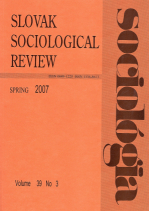Rodová segregácia na trhu práce v kontexte vzdelanostnej segregácie: medzinárodné porovnanie
Gender segregation in the labour market placed in the context of educational segregation: cross-national comparison
Author(s): Tomáš Katrňák, Marie Valentová, Iva ŠmídováSubject(s): Social Sciences
Published by: SAV - Slovenská akadémia vied - Sociologický ústav
Keywords: Gendered social structure; occupational gender segregation; educational segregation; gender analysis; cross-national comparison
Summary/Abstract: Gender Segregation in the Labour Market Placed in the Context of Educational Segregation: Cross-National Comparison. The position of women in the labour market may be analysed in many possible ways. In general, we can distinguish between two main approaches. The first one brings into focus the access to the labour market and works with indicators such as labour market participation, employment rates, unemployment rates, inactivity rates, duration of employment etc. The second approach deals with the issue of quality of labour market participation, which includes problems like occupational gender segregation, gender gap and labour market discrimination. This article focuses on the latter approach, in particular on the occupational gender segregation in relation to the gender segregation in education. The theory of human capital suggests that the increasing level of qualification, talents and productive skills of women acquired in the educational system, training and experience at work, should have a positive impact on quality of women‘s position in the labour market and enhance gender equality. Given the increasing educational attainment of women over the past decades, one would assume that their position in the labour market, including the gender segregation in occupational categories, has improved as well. However, the results of current research prove that despite all the changes and progress made with respect to the level of education of women, the level of occupational segregation tends to remain relatively stable over time. Thus, the increasing level of education does not seem to have a very strong impact on the overall level of gender segregation in occupations. One of the possible explanations may be the fact that women and men tend to choose different fields of study which predetermine their participation in particular categories of occupational structure to a larger extent than their level of education. Men are still over-represented in different fields of education than women and this tendency seems to persist even in the countries where a campaign has been led for the promotion of democratic and non-discriminatory practices in the system of education. The main aims of this article are: 1) to conduct a cross-national comparison of levels of occupational gender segregation and 2) to examine the relation between the level of occupational gender segregation and gender segregation in education (both vertical and horizontal). The analyses include 18 European countries covered by the European Social Survey (ESS) conducted in 2004. The comparison pays a special attention to differences and similarities between the EU-15 countries and the new EU member states, i.e. post-socialist countries.
Journal: Sociológia - Slovak Sociological Review
- Issue Year: 2007
- Issue No: 3
- Page Range: 214-244
- Page Count: 31
- Language: English

